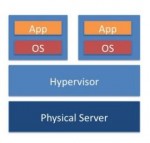One of my monthly health checks for our vSphere environment (which I’ll detail later) is to run a VUM (VMware Update Manager) scan of our ESXi hosts to see if they’re missing any patches. One of the things I love about ESXi is the fact that it does not have a full-blown Service Console like the “full” or “classic” ESX. This service console is based on redhat so any RedHat patches that are released by them are also needed on the ESX service console. But ESXi’s minimal service console isn’t based on RedHat and therefore doesn’t have all those extra pieces of software that need to be patched.
So ESXi patches don’t come out very often but I do make it a point to scan my hosts monthly and apply any updates that have come out. Usually these updates consist of updates to VMware Tools and then a new firmware image for ESXi.
This is the first month that I’ve implemented these monthly health checks and I’ll start by running that VUM scan.
We have two vCenter servers (which I’ll detail later) and they both have their own installation of VUM and their own patch repository. I do want to get to having a combined repository to save space, but they’re not very big so it’s not a big priority at the moment. The first vCenter server, Aero, which manages the ESXi hosts/clusters in our primary datacenter showed the “Update Manager” tab as expected when I clicked on the top-level vCenter server object in vCenter client, but when I went to check on Extra, our other vCenter server which manages the ESXi hosts/clusters in our secondary datacenter, the Update Manager tab was not present! It wasn’t there on any of the expected levels – vCenter server, Datacenter, Cluster, or Host.
I checked that the VUM plugin was installed and enabled on both my PC where I have the vSphere Client installed, and I also checked that it was installed and enabled on the vSphere Client which I’ve installed on the vCenter server Extra. It looked good but just to be safe, I disabled it and relaunched the client. No change. Then I uninstalled it from Add/Remove programs and installed it again via the client. No change. At this point, since I was seeing the behavior on both my PC and the vCenter server itself, I decided the problem must be with the VUM service itself. I restarted the VUM service on the vCenter server but that did not make any difference either.
I did a quick google search [missing “update manager” tab] and ended up at this post on the VMware Communities forum for vCenter Server: missing update manager tab where others had experienced the same problem. I knew that my issue was not that I hadn’t scrolled the tabs over far enough, and I didn’t understand the PATH issue that others had mentioned. I did check my PATH variable but it looked OK and we don’t use Norton products. We are running a 32-bit OS though, but we aren’t getting any messages about a lack of drive space. Either way, I decided to reinstall the VUM service. I visited the vSphere download page to see if there was a newer release than what I had previous downloaded, but there wasn’t.
I extracted the zip file for the VUM service which I had downloaded a few months ago when this latest release came out and copied the files up to my vCenter server. The structure inside the zip file containing the VUM install files is always a bit of a mystery. I navigated to the “bin” folder and found the VMware vCenter Update Manager.msi file which I right-clicked on and chose “Repair” just for fun. This failed saying it couldn’t register with the vCenter server or something, so then I right-clicked again and chose “Uninstall”. After verifying the service was no longer listed in Services, I doubleclicked on the VMware-UpdateManager.exe file to launch the installer.
I gave it credentials to connect to the vCenter server and reused the existing VUM tables inside my vCenter database. After the service was up and running, I launched vSphere Client and found that the Update Manager tab was back! I doublechecked the settings in “Admin View” and found that the Patch download schedule wasn’t really configured correctly. I set it to run every day and email me when new patches are found. I also made sure to set the time to be within a few minutes. Soon the task started and apparently didn’t have to download much because it ended pretty quickly.
I was then able to rescan the datacenter and find that my ESXi hosts are missing 1-2 patches.
I will write about how we use Update Manager at a later point but just wanted to point out that sometimes it just comes down to reinstalling a product to get it to work correctly. Luckily the configuration is stored in a database and that was able to be reused so reinstalling it wasn’t any big deal. There’s not much to configure anyway with VUM but it’s nice to be able to reuse the database.
